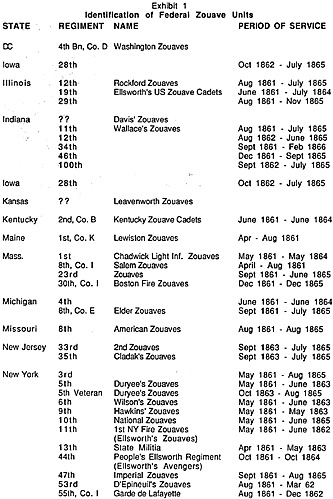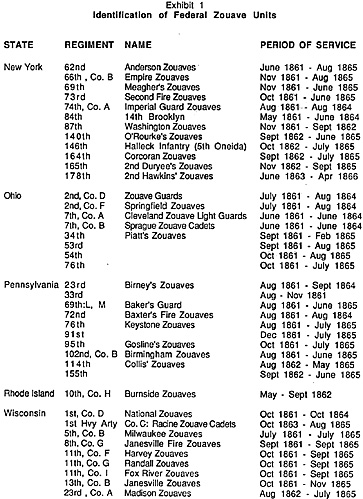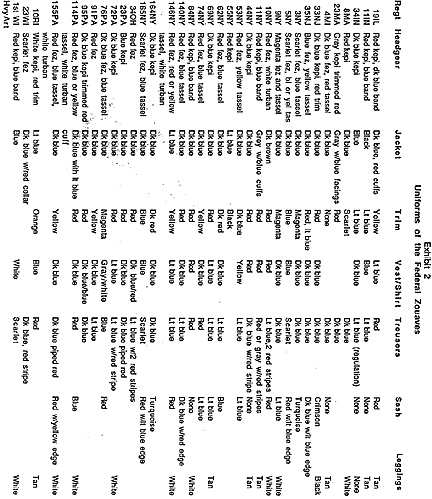ELMER ELLS WORTH AND THE YANKEE ZOUAVE
On April 16, 1859, Elmer Ephraim Ellsworth was visited by the secretary of the Chicago National Guard Cadets and presented a letter notifying him of his election as the unit's new captain. Ellsworth, only 22 years old, already held a local reputation as a talented drillmaster. He was concerned that this further obligation might detract from his study of law. Ellsworth accepted the commission reluctantly; he explained he could give the Cadets "but one night a week". One month later. Ellsworth was holding drill three times a week, and he had "changed the company entirely and in every particular, uniform and all" (Randall 118). No longer were they "National Guards". Their new name was the United States Zouave Cadets.
By Independence Day the Cadets were ready to exhibit their "Zouave drill" to cheering Chicago crowds. That September, they surprised everyone -- including Ellsworth -- by winning the drill competition at the National Agricultural Society meeting in Springfiled, illinois. No matter that only one other company entered the contest or that protest from the unrepresented South and East disputed the championship. Elmer Ellsworth and his Zouave Cadets had the nation's attention.
In 1830, a North African tribe called the Zouaoua volunteered to serve in the French army in Algiers. The campaigns of the French Marshal Bugeaud and his romantic-sounding Zouaves, chasseurs, spahis and Foreign Legionnaires against the desert tribes seemed to stimulate the writers of the time (Dupuy 781). With the Crimean War, the Zouaves again came to the public's attention, and as the interest in Napoleon III grew, so did interest in French military institutions.
The Zouave in his fez, collarless jacket and loose flowing pants became an exotic example of the military virtues. The French Zouaves that Ellsworth so much admired would even make an appearance in the Americas, though not in his lifetime. Soldiers from the three Zouave regiments served in the French contingent supporting the Archduke Maximilian in Mexico from 1865 to 1867 (Allsop 43).
The United States Zouave Cadets were selected as the Governor's Guard of Illinois in January 1860. For Ellsworth, this honor had two important impacts. First, it gave his Zouave Cadets an even greater reputation and wider public exposure. Secondly, it brought him into close contact with John Hay and Abraham Lincoln.
In June 1860, Ellsworth published his Manual of Arms for Light Infantry for the U.S. Zouave Cadets, after translating the drill from the French (Randall 173). Copies sold briskly, perhaps in anticipation of the Cadets' upcoming eastern tour. In July, the Zouave Cadets departed Chicago on a twenty-city tour that included New York City, West Point and Washington, D.C., before returning home through St. Louis, Springfield and Chicago. This tour popularized the Zouave drill -- and the Zouave uniform -- with the Northern public.
By March 1861, Ellsworth had resigned his command of the United States Zouave Cadets and was in Washington to receive his lieutenants commission from his friend and admirer, Abraham Lincoln. When Lincoln issued the call for 75,000 volunteers in April, Ellsworth responded by resigning his lieutenancy and going to New York. There his reputation helped him raise a Zouave regiment from men of the fire departments of the city.
On April 29th, now-Colonel Ellsworth and his full regiment of New York Fire Zouaves left by steamer for the Capitol. Many Washington dignitaries, including the Chief Executive, watched on as Ellsworth's troops were sworn in on May 7 as the 11th New York Infantry Regiment (Randall 239). The Zouaves were now "in for the war".
ZOUAVES OF THE UNION ARMY
Writing in 1970, Lord and Wise claimed that at least 50 Zouave units served in the Union Army during the Civil War. More recent work by Brian Pohanka and Patrick Schroeder for the Fort Ward Museum in Alexandria, Virginia, identified more than 70 Federal regiments with one or more companies calling themselves Zouaves. (Units such as the 18th Massachussetts, 62nd and 83rd Pennsylvania, and 49th and 72nd New York that wore the French Chasseur uniform are excluded from this count). Some of these 70 units wore Zouave dress only briefly, if at all. A number, more than is usually recognized, wore Zouave dress for an extended period. The Zouave uniform was not just a phenomenon of the early war. At least seven regiments of the Army of the Potomac still wore Zouave dress at the close of the war (McAfee 31).
Exhibit 1 lists known Zouave units by regimental number and by name. Exhibit 1 also shows the period of service of the regiment as given in Dyer's Compendium. This is not specifically the period of Zouave dress but is offered as a rough guide to the wargamer.
UNIFORMS OF THE YANKEE ZOUAVES
The distinguishing feature of the Zouave uniform was the short jacket, best described as a "vest with sleeves". The jacket was usually edged in the unit's "trim" color, and each cuff was normally adorned with a single narrow chevron in the trim color, the chevron beginning a few inches up the sleeve and pointing away from the jacket cuff. It was also common for the jacket to show a single width of trim on each front breast that ran from low on the inside edge of the jacket up to the chest, ending in three open loops in the shape of a trefoil. Headgear might be the kepi or the traditional Zouave fez. Trousers might be baggy in true Zouave style or more closely cut. When they wore out, they were often replaced with the sky blue trousers of regulation issue. Sometimes the uniform included a wide sash worn around the waist and tied in a draping fashion at the left hip. Leggings or gaiters were another optional touch in the Zouave's attire.
The French Zouaves were copied most closely by the 5th New York, Duryee's Zouaves (Katcher, 1986, 4.6). Raised in 1861 by New York merchantAbram Duryee, the 5th New York compiled an impressive combat record with the Army of the Potomac. When its enlistments expired in 1863, many of its veterans returned as the 5th New York Veteran Volunteer Infantry to wear the Zouave uniform through to Appomattox.
In contrast, Zouaves from the western states often wore very simplified dress. Frequently, only the collarless jacket identifies them as Zouaves, all other uniform items being identical to government issue.
The Uniform information in Exhibit 2 is intended for use in painting Zouaves in wargaming scales. Painters of figures requiring more detail would do well to consult the sources listed at the conclusion of this article. Uniform data has been summarized from secondary sources; research into primary sources might well yield variations from these details.
Exhibit 2 shows that the "red-legged Zouave" so popular in the Northern press was the exception rather than the rule in Zouave dress. Based on this information, dark blue or light blue trousers are both twice as common as red ones, and the kepi is worn almost as often as the fez. Perhaps readers of The Zouave can provide uniform data for units listed in Exhibit I but not in Exhibit 2.
CONCLUSION
Elmer Ellsworth did not live to see the popularity that the Zouave uniform would attain. On May 24, 1861, he led the 11th New York from Washington, D.C., across the Potomac to Virginia. His objective was an offending Stars and Bars flying from a hotel in Alexandria. His mission accomplished, he and his Zouaves descended the stairs from the rooftop to be confronted by the irate innkeeper. The innkeeper fired, and Ellsworth was mortally wounded.
Elmer Ephraim Ellsworth gave the Union Army its first fallen hero. He gave American military history the Yankee Zouave.
SOURCES
Alsop, David and Anthony G. Canavan, The Maximilian War 1861-1867, Frei Korps 15, 1984.
Dyer, Frederick H., A Compendium of the War of the Rebellion, 1908, reprint by Morningside Bookshop, 1978.
Dupuy, R. Earnest and Trevor N. Dupuy, The Encyclopedia of Military History From 3500 B.C. to the Present, Harper & Row, 1970.
Elting, Col. John R., and Michael J. McAfee, Long Endure: The Civil War Period 1852 -1867, Military Uniforms In America Volume III, Presidio Press, 1982.
Haythornthwaite. Philip, Uniforms of the Civil War 1861-1865, Macmillan Publishing Company, 1976.
Katcher, Philip, American Civil War Armies (2): Artillery. Cavalry and Infantry, Osprey Publishing Ltd., 1989.
American Civil War Armies (5): Volunteer Militia, Osprey Publishing Ltd., 1989.
Army of the Potomac, Osprey Publishing Ltd., 1975.
Lord, Francis A. and Arthur Wise, Uniforms of the Civil War, Thomas Yoseloff, 1970.
McAfee, Michael J., Zouaves. ..The First and the Bravest, West Point Museum Bulletin, United States Military Academy, 1979.
Randall, Ruth Painter. Colonel Elmer Ellsworth, Little, Brown and Company. 1960. Zouaves!, Fort Ward Museum, Alexandria, Virginia.
[Editor's Note!: We have been vety fortunate through the years to have members whose interest in the Civil War extends beyond miniature gaming and into the realm of true historian. Bill Winter is to be highly commended for the many, many hours of research that went into his article and accompanying Exhibits. I personally feel honored that Bill chose to direct his writing to this magazine when so many other publications would have been more than happy to receive it. This article ranks up there, in my personal opinion, with Ryan Toews' article on flags of New York units as the best historical miniatures related article ever received by this magazine. To say that I am pleased to publish it would be an understatment!



Back to The Zouave Vol IV No. 3 Table of Contents
Back to The Zouave List of Issues
Back to Master Magazine List
© Copyright 1990 The American Civil War Society
This article appears in MagWeb (Magazine Web) on the Internet World Wide Web.
Other military history articles and gaming articles are available at http://www.magweb.com